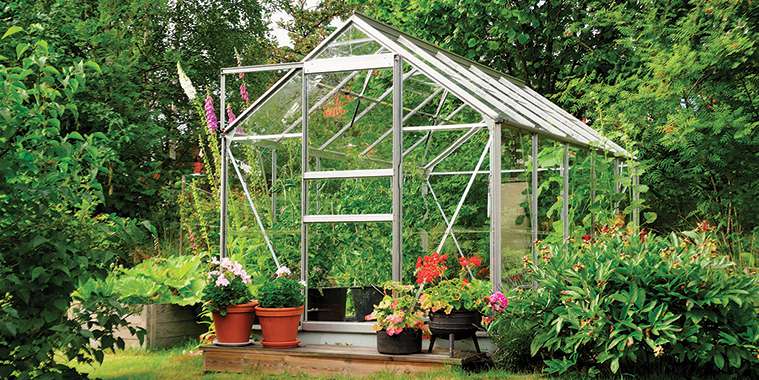We’ve enjoyed some unexpected benefits from spending so much more time at home. You may have discovered — or at least considered — your thumb is far greener than you ever thought.
You’re not alone as nearly half of Canadians turned soil to grow their own food in 2020 as a result of the COVID-19 pandemic. Now that it’s time to start planning for the next growing season, let’s take a look at why a DIY greenhouse could be the perfect thing to kick your gardening efforts up a notch.
Why a greenhouse?
The Canadian growing season is short, especially farther north, and a greenhouse is the perfect way to start plants that need extra time to establish before planting them outside in the ground. It also provides protection to seedlings so pesky squirrels, slugs, and other insects don’t get to eat the fruits of your labour before you do — making it an outstanding alternative to an open air garden altogether. A greenhouse opens up more options for produce that would not normally thrive in our temperate climate. Plus, if you take the extra steps with a heated four-season greenhouse, you can grow year-round and add to your winter landscape.
Can I really build my own?
You may question whether or not this is something you can do on your own with little or no building experience. Fortunately, there are many ways to accomplish this project. If you prefer a turn-key solution, there are plenty of kits of all sizes out there.
If you prefer to build your own from scratch, then you may find the perfect set of plans in this epic list compiled by Morning Chores at morningchores.com for 122 free DIY greenhouse plans. For you expert builders, that list makes a great starting point to inspire your own design!
When planning for a greenhouse, one of the most common issues growers encounter is running out of space too quickly. Always plan a little larger than you think you might need (if space allows). There are also ways to make the most of your space like layering, increasing your surface area, or staggering crops.
Although most kits are small, a building permit may be required to construct larger or more complex greenhouses, especially if your goal is a heated three-to-four season setup. Check with your municipality to ensure you’re following building codes and to apply for a permit if necessary.
Plants for the beginner
If you’re just starting out, sticking to species that are easy to grow is an excellent way to build confidence and gain experience to succeed in this endeavour. Here are some veggies and herbs that can thrive under the most basic of conditions and care:
• Tomatoes Tomatoes can be remarkably easy to grow, and can produce loads of fruit through the late summer and into the fall.
• Zucchini This delicious squash variety is perfect for the beginner gardener and will continue to flower and produce fruit right up until the first frost. Just make sure to harvest them every few days so they don’t get too big.
• Spinach Spinach is delicious and versatile, easily fitting into many raw and cooked dishes.
• Lettuce From red and green leaf lettuce to juicy romaine or iceberg, your salad game will be spot-on with these easy-to-grow greens.
• Cucumbers Cucumber varieties are relatively easy to grow, and perfect for both raw and pickling applications. Like zucchini you need to keep an eye on their size once they start to ripen.
• Carrots These delicious and popular root vegetables are a breeze to plant and maintain in a greenhouse setting.
• Green (spring) onions A staple for salads, omelettes or garnish for stir-fry, green onions are super easy to grow. You can even start them from leftovers you bought at the grocery store as long as they still have their roots. You can also continually harvest them by snipping off the tops as needed and leaving the rest to re-grow.
• Strawberries This sweet, delicious early summer fruit is surprisingly simple to grow, and there are even varieties that produce continually as long as the ambient temperature remains moderate.
Many herbs grow quite well in Canada’s climate, and will thrive in a greenhouse setting. If you’re planting outside, be aware most herbs are perennial and will come back each year. Varieties like mint, lemon balm, chives, and parsley spread quickly (keep an eye on them if you are planting outside). Here are a few must-haves: Parsley, sage; summer savoury, oregano, basil, thyme, dill, fennel, mint, cilantro, lemon balm chives.
Two important considerations
Because the sun can be quite piercing and glass windows can amplify its heat and intensity, it may be necessary to take additional steps to moderate the temperature and light penetration, like employing a shade or enabling ventilation.
While some plants require little-to-no help with pollination, if you plan to grow in a fully enclosed greenhouse for the duration of your plants’ life cycles, some assistance may be necessary to ensure a healthy crop.
Building a greenhouse to grow your own produce is an amazing hobby with benefits to your health beyond just the expected fresh and nutritious harvest. It’s a great — even cost-friendly — way to learn new skills, relieve stress, build confidence and make opportunities for valuable family time — even for the most timid of green thumbs.
— Realtor.ca



